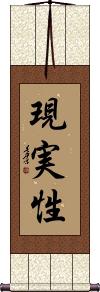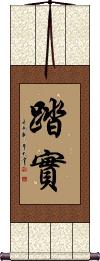Many custom options...
And formats...

Realistic Practical in Chinese / Japanese...
Buy a Realistic Practical calligraphy wall scroll here!
Personalize your custom “Realistic Practical” project by clicking the button next to your favorite “Realistic Practical” title below...
Reality / Realistic
現実性 is a Japanese word that expresses the idea of reality or coming to understand what is true and real.
This can also be translated as realistic, practical, or feasible.
See Also: Illusion
Realistic / Practical
Realistic / Practical
Keep Your Feet on the Ground
Be Down-to-Earth
腳踏實地 is a four-character proverb that suggests that you should be practical, realistic, and grounded.
Some translate this as a suggestion to be down-to-earth.
The first character means “feet.”
The second means “step on” or “stand.”
The third means “solid,” “real,” or “true.”
The last character means “ground,” “earth,” or “terra.”
Literally, this means “[keep your] Feet Standing [on] Solid Ground.”
Not the results for realistic practical that you were looking for?
Below are some entries from our dictionary that may match your realistic practical search...
| Characters If shown, 2nd row is Simp. Chinese |
Pronunciation Romanization |
Simple Dictionary Definition |
現実性 see styles |
genjitsusei / genjitsuse げんじつせい |
More info & calligraphy: Reality / Realistic |
切實 切实 see styles |
qiè shí qie4 shi2 ch`ieh shih chieh shih |
feasible; realistic; practical; earnestly; conscientiously |
實際 实际 see styles |
shí jì shi2 ji4 shih chi jissai |
reality; practice; practical; realistic; real; actual The region of Reality. |
即物的 see styles |
sokubutsuteki そくぶつてき |
(adjectival noun) practical; matter-of-fact; realistic; utilitarian; pragmatic |
実際的 see styles |
jissaiteki じっさいてき |
(adjectival noun) practical; realistic; pragmatic |
實事求是 实事求是 see styles |
shí shì qiú shì shi2 shi4 qiu2 shi4 shih shih ch`iu shih shih shih chiu shih |
lit. to seek truth from facts (idiom); fig. to be practical and realistic |
地に足の着いた see styles |
chiniashinotsuita ちにあしのついた |
(exp,adj-f) (idiom) realistic; practical; grounded |
The following table may be helpful for those studying Chinese or Japanese...
| Title | Characters | Romaji (Romanized Japanese) | Various forms of Romanized Chinese | |
| Reality Realistic | 現実性 | gen jitsu sei genjitsusei | ||
| Realistic Practical | 現実主義 | genjitsu shugi / genjisu syugi | ||
| Realistic Practical | 踏實 踏实 | tā shí / ta1 shi2 / ta shi / tashi | t`a shih / tashih / ta shih | |
| Keep Your Feet on the Ground | 腳踏實地 脚踏实地 | jiǎo tà shí dì jiao3 ta4 shi2 di4 jiao ta shi di jiaotashidi | chiao t`a shih ti chiaotashihti chiao ta shih ti |
|
| In some entries above you will see that characters have different versions above and below a line. In these cases, the characters above the line are Traditional Chinese, while the ones below are Simplified Chinese. | ||||
Successful Chinese Character and Japanese Kanji calligraphy searches within the last few hours...







